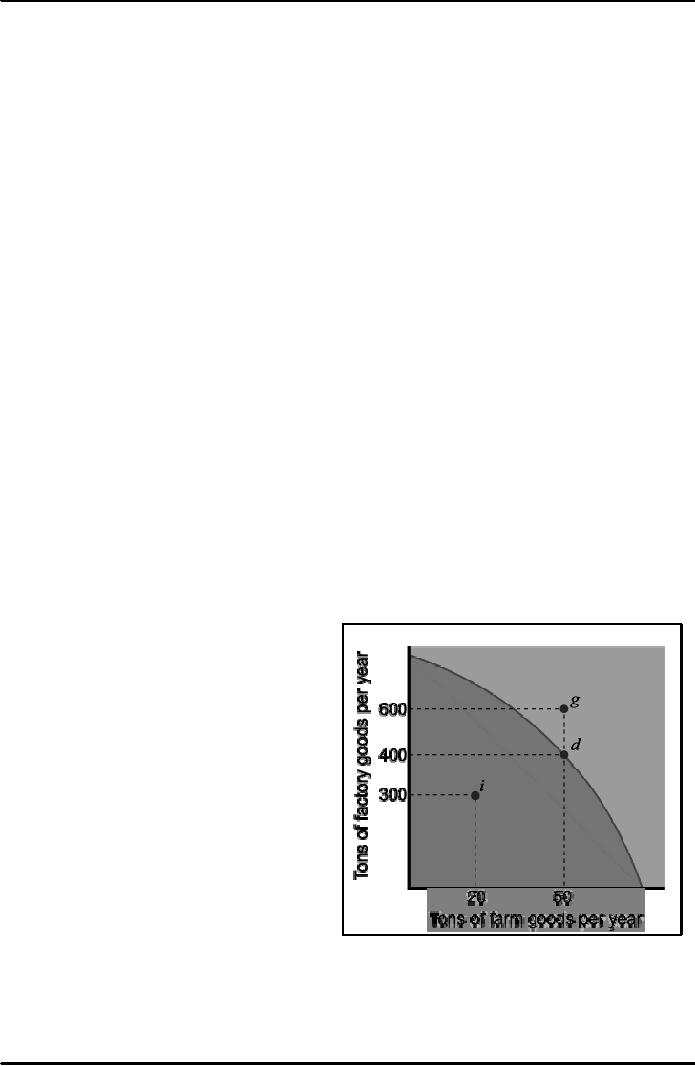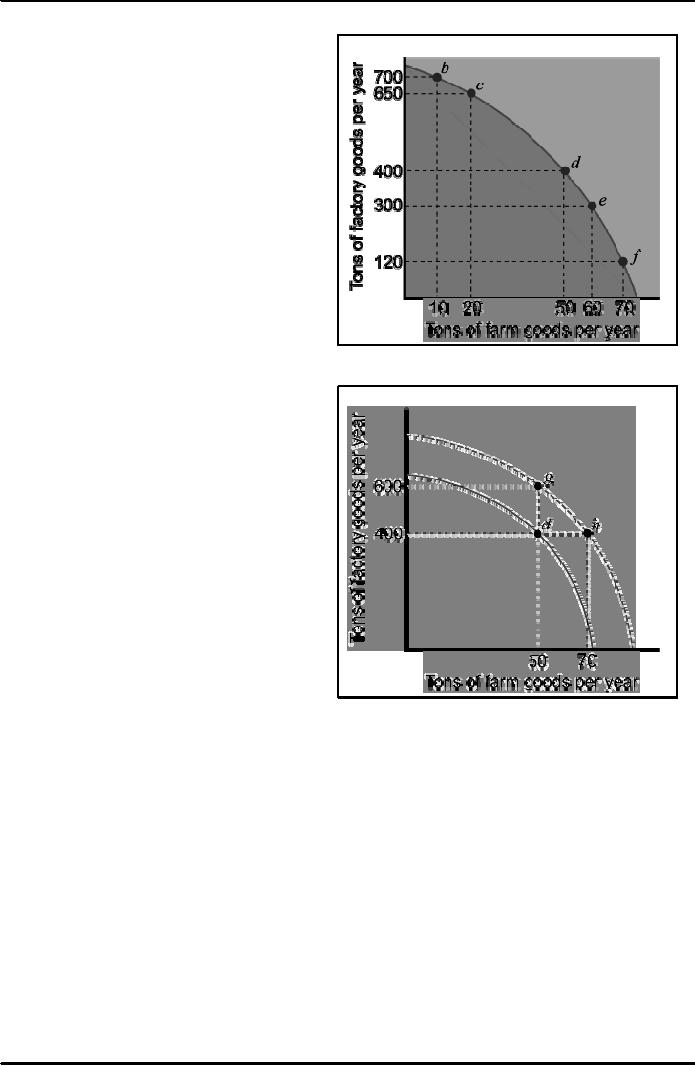 |
Economics: Another Perspective, Factors of Production |
| << ECONOMICS:Themes of Microeconomics, Theories and Models |
| REAL VERSUS NOMINAL PRICES:SUPPLY AND DEMAND, The Demand Curve >> |

Microeconomics
ECO402
VU
Lesson
2
Economics;
Another Perspective
Economics is
the study of the choices
made by people who are
faced with scarcity.
Scarcity
is a situation in which resources
are limited but can be
used in different
ways;
so
one good or service must be
sacrificed for
another.
Society's
Choices
The
decisions of producers, consumers
and government determine how
an economic
system
answers three fundamental
questions:
1.
What products do we
produce?
2.
How do we produce these
products?
3.
Who consumes the
products?
Factors
of Production
Factors
of production are the
resources that are used to
produce goods and
services:
1.
Natural resources:
The
things created by acts of
nature such as land, water,
mineral, oil and
gas
deposits,
renewable and nonrenewable
resources.
2.
Labor:
The
human effort, physical and
mental, used by workers in
the production of
goods
and
services.
3.
Physical capital.
All
the machines, buildings,
equipment, roads and other
objects made by human
beings
to produce goods and
services.
4.
Human capital:
The
knowledge and skills
acquired by a worker through
education and
experience.
5.
Entrepreneurship:
The
effort to coordinate the
production and sale of goods
and services.
Entrepreneurs
take risk and commit
time and money to a business
without any
guarantee
of profit.
The
Production Possibilities
Frontier
(PPF)
The
PPF curve shows
the possible
combinations
of goods and
services
available
to an economy, given that
all
productive
resources are fully and
efficiently
employed.
When
the economy is at point
i,
resources
are
not fully employed and/or
they are not
used
efficiently. Point g
is
desirable because
it
yields more of both goods,
but not
attainable
given the amount of
resources
available.
Point d
is
one of the possible
combinations
of goods produced
when
resources
are fully and efficiently
employed.
3

Microeconomics
ECO402
VU
Scarcity
and the PPF
To
increase the amount of farm
goods by
10
tons, we must sacrifice 100
tons of
factory
goods.
The
PPF curve is bowed out
because
resources
are not perfectly adaptable
to the
production
of the two goods. As
we
increase
the production of one good,
we
sacrifice
progressively more of the
other.
Shifting
the PPF Curve
To
increase the production of
one good
without
decreasing the production of
the
other,
the PPF curve must
shift outward.
The
PPF curve shifts outward as
a result of
an
increase in the economy's
resources OR
a
technological innovation that
increases
the
output obtained from a given
amount of
resources.
From point d,
an additional 200
tons
of factory goods or 20 tons of
farm
goods
are now possible
(or any
combination
in between).
4
Table of Contents:
- ECONOMICS:Themes of Microeconomics, Theories and Models
- Economics: Another Perspective, Factors of Production
- REAL VERSUS NOMINAL PRICES:SUPPLY AND DEMAND, The Demand Curve
- Changes in Market Equilibrium:Market for College Education
- Elasticities of supply and demand:The Demand for Gasoline
- Consumer Behavior:Consumer Preferences, Indifference curves
- CONSUMER PREFERENCES:Budget Constraints, Consumer Choice
- Note it is repeated:Consumer Preferences, Revealed Preferences
- MARGINAL UTILITY AND CONSUMER CHOICE:COST-OF-LIVING INDEXES
- Review of Consumer Equilibrium:INDIVIDUAL DEMAND, An Inferior Good
- Income & Substitution Effects:Determining the Market Demand Curve
- The Aggregate Demand For Wheat:NETWORK EXTERNALITIES
- Describing Risk:Unequal Probability Outcomes
- PREFERENCES TOWARD RISK:Risk Premium, Indifference Curve
- PREFERENCES TOWARD RISK:Reducing Risk, The Demand for Risky Assets
- The Technology of Production:Production Function for Food
- Production with Two Variable Inputs:Returns to Scale
- Measuring Cost: Which Costs Matter?:Cost in the Short Run
- A Firm’s Short-Run Costs ($):The Effect of Effluent Fees on Firms’ Input Choices
- Cost in the Long Run:Long-Run Cost with Economies & Diseconomies of Scale
- Production with Two Outputs--Economies of Scope:Cubic Cost Function
- Perfectly Competitive Markets:Choosing Output in Short Run
- A Competitive Firm Incurring Losses:Industry Supply in Short Run
- Elasticity of Market Supply:Producer Surplus for a Market
- Elasticity of Market Supply:Long-Run Competitive Equilibrium
- Elasticity of Market Supply:The Industry’s Long-Run Supply Curve
- Elasticity of Market Supply:Welfare loss if price is held below market-clearing level
- Price Supports:Supply Restrictions, Import Quotas and Tariffs
- The Sugar Quota:The Impact of a Tax or Subsidy, Subsidy
- Perfect Competition:Total, Marginal, and Average Revenue
- Perfect Competition:Effect of Excise Tax on Monopolist
- Monopoly:Elasticity of Demand and Price Markup, Sources of Monopoly Power
- The Social Costs of Monopoly Power:Price Regulation, Monopsony
- Monopsony Power:Pricing With Market Power, Capturing Consumer Surplus
- Monopsony Power:THE ECONOMICS OF COUPONS AND REBATES
- Airline Fares:Elasticities of Demand for Air Travel, The Two-Part Tariff
- Bundling:Consumption Decisions When Products are Bundled
- Bundling:Mixed Versus Pure Bundling, Effects of Advertising
- MONOPOLISTIC COMPETITION:Monopolistic Competition in the Market for Colas and Coffee
- OLIGOPOLY:Duopoly Example, Price Competition
- Competition Versus Collusion:The Prisoners’ Dilemma, Implications of the Prisoners
- COMPETITIVE FACTOR MARKETS:Marginal Revenue Product
- Competitive Factor Markets:The Demand for Jet Fuel
- Equilibrium in a Competitive Factor Market:Labor Market Equilibrium
- Factor Markets with Monopoly Power:Monopoly Power of Sellers of Labor